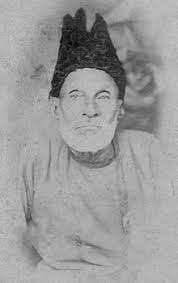Sweet Surrender
- Bengal, the ‘sweet’ capital of India, excels in creative confectionaries. The generic name monda-mithai was given to Bengal sweets. While monda was khoya (milk solid) based, mithai used flour as the base material. Additional ingredients used were jiggery, coconut, puffed rice etc. The mention of Bengal sweets can be traced back to the medieval literature Mangal kavya.
- Today, the iconic Bengali ‘mishti’ is mostly based on chhana (curdled milk, cottage cheese) as opposed to the khoya used in other parts of India. Assorted flavors are added to chhana giving rise to a plethora of sweets each renowned for its distinctive taste, odor, shape, color and texture. It is believed that the art of chhana making was introduced by the Portuguese settlers.
- The six earliest sweet makers or moiras who left a permanent mark on the sweet canvas of Bengal were Paran Chandra Nag, Mahesh Chandra Dey, Nobin Chandra Das, Dwariknath Ghosh, Asutosh Sen and Ganguram Chaurasia.
Bhim Chandra Nag –
Founded by Paran Chandra Nag in 1826 near Bowbazar market, this iconic shop was
later handed over to Asutosh Chandra Nag. Initially famous for the quality of
the sandesh, many new varieties like sakuntala sandesh, nebru sandesh,
badshah bhog, paritripti, dilkhush, peshawari and
others were introduced. Rani Rashmoni is said to have purchased 15 kg of the abar
khabo sweet daily for offering to the Bhavatarini deity of Dakshineshwar.
The iconic fried sweet ledikeni is said to have been invented on the
birthday of Lady Canning, wife of the first Viceroy of British India. Several
visionaries of Bengal were patrons here.
Girish Chandra Dey and Nakur Chandra Nandy – Located at 56 Ramdulal Street, Girish Chandra Dey and Nokur
Chandra Nandy is a famous sweet shop intricately woven into Bengali culture and
cuisine since 1844. Nakur Chandra Nandy hailed from Janai in Hoogly district
and came to Calcutta as son-in-law of renowned confectioner of Simla, Girish
Chandra Dey. The later had inherited the shop from his father Mahesh Dey. The
signature items include talsash, jalbhara, parijat, dilkhush, monohara,
singara sandesh and other varieties. This shop has catered to the taste
buds of Satyajit Ray, Uttam Kumar, Rajib Gandhi, Narendra Modi, the Bachchans
and Hillary Clinton among several others. Upgradation and innovation of sweets
are a salint feature here.
Punti Ram (College Street) set
up in 1852 keeps tickling the Bengali taste bud with Dalpuri, chholar daal,
kochuri and Raj Bhog that in Bengali means royal meal. Other delicacies include
sweets such as Abar Khabo and Sonpapri, Rosogolla, Lyangcha,
Komolabhog, Kheer Chop, Kaju Barfi and Dorbesh.
K. C. Das – The distinctive
shop at Esplanade crossing is a prominent thread in the sweet fabric of Bengal.
This shop is credited to have invented the rasogolla in 1868, which after
a long drawn tussle, received the GI of Banglar rasogolla in 2017. This
sweet was popularized by a Marwari businessman, Rai Bahadur Bhagwandas Bagla. Nobin
Chandra Das was the founder of this business after two previous attempts at
Jorasankho (1864) and Bagbazar (1866). The abar khabo sweet was a favorite of Maharani
Swarnamoyee Debi of Cossimbazar and Ma Sarada Devi was particularly fond of dedo
sandesh. After his death in 1925, the reigns of the shop were handed over
to his wife Kshirodomoni Devi, the granddaughter of Bhola Moira. In 1930, Krishna
Chandra Das Confectioner was founded and packaging of rasogollas in vacuum
cans was started. The present set up at Esplanade was opened in 1935 by Sarada
Charan Das in his father’s name. To him goes the credit of introducing card
board boxes with butter paper lining as opposed to the traditional leaf
packing. Amrita kumbha sandesh was invented by him. Savoury items were introduced later.
Dwarik’s Grandson- Dwariknath
Ghosh hailing from Howrah set up his shop at Shyambazar in 1885 named as
Dwariknath Ghosh and Sons. Later on, from 1920s, branches were opened all over
Calcutta and were collectively termed as Dwarik’s Grandsons. People cherish chitrakoot,
darbesh, rajbhog, kanchagolla etc from here.
Sen Mahasay- In
1885, Asutosh Sen founded Sen Mahasay on Shibdas Bhaduri Street, Fariapukur.
Later on it was taken up by his nephew Nilmoni Sen. On 15th August 1947;
the shop introduced Jai Hind, a tricolored sandesh which it prepares on days of
national significance. Today several branches are present all over Kolkata.
Ganguram- Founded
by Ganguram Chaurasia in 1892, the first shop was at Vivekananda Road,
Maniktala. The shop was set up by the patronage of Raja Kamala Prasad
Mukherjee, the employer of Chaurasia. Later branches have spread all over
Kolkata. Among several other sweets, Milk crown, Indrani and labongo
lotika are famous here.
Balaram Mulick and Radharaman Mullick - Ganesh Chandra Mullick came to Calcutta from Konnagar in
1880. He purchased a land from the famous Harlalkar family at Bhowanipore to
set up his shop. Korapak and Nolen Gur items became famous and
Sir Ashutosh Mukherjee was a great admirer of "Guli Sandesh".
The tradition of Ganesh Mullick was carried forward by his brother Balaram and
his son Radharaman, as the confectioners became famous for their fresh and
quality sweetmeats.
Other traditional sweet shops
Adi Haridas Modak Mishtanna Bhandar (1780, Shyambazar)
Naba Krishna Guin (1809, Bowbazar)
Makhan Lal Das and Sons (1827, Rabindra Sarani)
Nalin Chandra Das and Sons (1841, Rabindra Sarani)
Nobin Chandra Das (1864, Sovabazar)
Gupta Brothers (1888, Lala Lajpat Ray Sarani)
Jayasree (approx. 1890, Bowbazar)
Chittaranjan Mishtanna Bhandar (1907, Shyambazar)
Amrit (1912, Shyambazar)
Bhabatarini Mishtanna Bhandar (1952, Shyambazar)
Mithai (1995, Park Circus)
References:
A taste of time by Mohona Kanjilal
https://balarammullick.com/cms/legacy
https://www.shoestringtravel.in/2019/07/heritage-sweet-shops-in-kolkata.html



Comments
Post a Comment